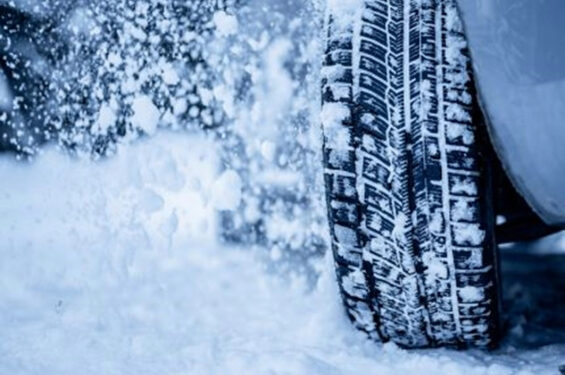
When it comes to winter driving, snow tires and chains can help you navigate the roads more safely. Learn about how they work, the conditions they’re best for and how to choose the best option for you.
What are snow tires?
The rubber in snow tires is made to be flexible in the cold, which helps give them a good grip on winter roads. Snow tires also have sharp edges and small cuts to help with traction. They work best when driving on paved roads that have frozen (with or without snow), on packed snow, on icy roads and deeper snow-covered roads. [1]
What are studded snow tires?
To provide more grip, studded snow tires include metal spikes, or studs, in the treads. They work best when driving on ice and packed snow. [1]
What are snow chains?
Snow chains wrap around tires to offer more traction, guard against slipping and prevent wheels from spinning. They work best when driving in heavy snow and mountainous areas. [2]
What’s the difference between snow tires vs. chains?
There are a few things to consider as you evaluate the differences between snow tires and chains and decide what option is best for your driving needs.
- Climate: In a location with lengthy, cold, snowy winters, snow tires offer extra traction all season long. For infrequent winter driving, a more temporary solution such as snow chains could be convenient. [2]
- Installation: Snow tires need to be installed each winter and removed when the weather warms up. Tire chains can be installed as needed but require the driver to learn the process. [2]
- State regulations: From tire chain requirements to restrictions on studded tires, regulations vary from state to state. [3]
- Price: The cost for snow tires is higher than for a set of snow chains. [1]
Pros and cons of snow tires
Pros of snow tires:
- Designed for driving in winter weather, snow tires are an all-around solution that helps you safely and confidently navigate snow and ice
- Their flexible material means they could last longer than all-weather tires [2]
Cons of snow tires:
- There can be state restrictions on the types of snow tires you’re allowed to use
- Buying and changing another set of tires means more costs and logistics [2]
Pros and cons of tire chains
Pros of chains:
- If you don’t regularly drive in winter weather, chains are an economical option that can be installed when needed
- Chains are very helpful for driving in deep snow or on mountain roads [2]
Cons of chains:
- There can be state restrictions or limitations on the use of chains
- Installation can be tricky if you’re unfamiliar with the process, and doing it incorrectly can damage a vehicle [2]
Snow chain and tire maintenance
Once you decide on the best option for your situation, there are a few steps you can take to keep snow chains and snow tires in top condition.
- Snow chains: Clean off dirt and salt after every use with a brush or garden hose and mild detergent, if needed. Before storing the chains, inspect them for damage or worn-out parts, apply a rust-inhibiting product (check the owner’s manual for specifics), and then keep them in a dry location. [4]
- Snow tires: Save extra wear and tear on snow tires by changing them out for all-season tires once temperatures are consistently above 45 degrees. Storing the tires indoors is ideal, somewhere that’s cool, dry and out of direct sunlight. [5]
Find out more about protecting your car in the winter and throughout the year with the right auto insurance.
Sources:
[1] “Are Winter Tires Better Than Chains?” Michael Hartley, forbes.com/sites/michaelharley/2024/01/07/are-winter-tires-better-than-chains/ (Accessed August 2024).
[2] “Snow Tires vs. Chains: Which Is Better?” autozone.com/diy/wheel/snow-tires-vs-snow-chains (Accessed August 2024).
[3] “Tire Chain Laws and Regulations by State,” tirechain.com/tirechains-com-tire-chain-laws-and-regulations-by-state/ (Accessed July 2024).
[4] “How to maintain and store tire chains,” tirechain.com/blog/how-to-maintain-and-store-tire-chains/ (Accessed August 2024).
[5] “When to put on Winter Tires,” goodyear.com/en_US/learn/tire-care-maintenance/when-to-put-on-winter-tires.html (Accessed August 2024).
Get peace of mind with Nationwide auto insurance
Protect yourself and your vehicle with an auto insurance policy from Nationwide. Learn about what we cover and see how you can save on a policy today.

Disclaimer:
The information included is designed for informational purposes only. It is not legal, tax, financial or any other sort of advice, nor is it a substitute for such advice. The information may not apply to your specific situation. We have tried to make sure the information is accurate, but it could be outdated or even inaccurate in parts. It is the reader’s responsibility to comply with any applicable local, state or federal regulations. Nationwide Mutual Insurance Company, its affiliates and their employees make no warranties about the information nor guarantee of results, and they assume no liability in connection with the information provided. Nationwide, the Nationwide N and Eagle and Nationwide is on your side are service marks of Nationwide Mutual Insurance Company. © 2024 Nationwide



